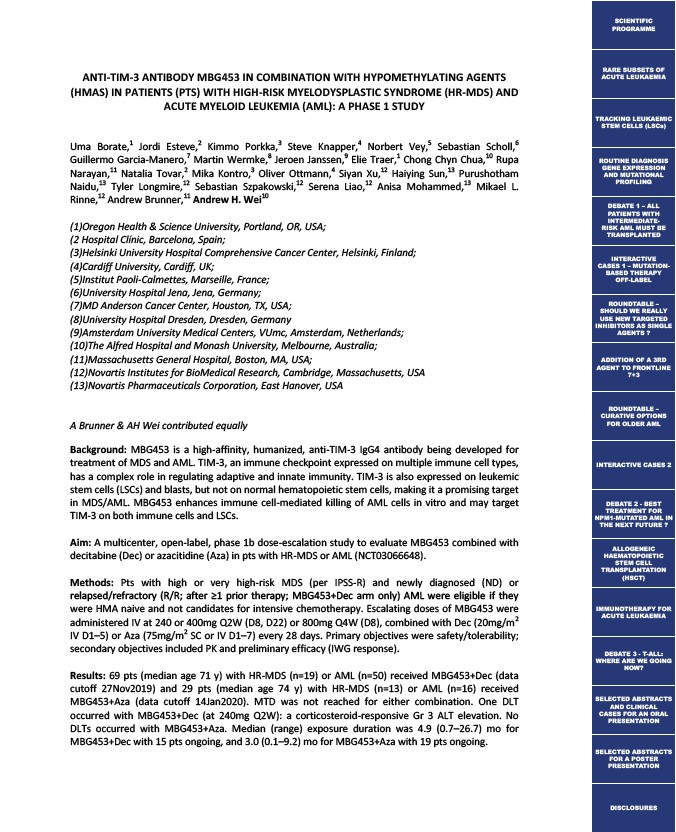
ANTI-TIM-3 ANTIBODY MBG453 IN COMBINATION WITH HYPOMETHYLATING AGENTS
(HMAS) IN PATIENTS (PTS) WITH HIGH-RISK MYELODYSPLASTIC SYNDROME (HR-MDS) AND
ACUTE MYELOID LEUKEMIA (AML): A PHASE 1 STUDY
Uma Borate,1 Jordi Esteve,2 Kimmo Porkka,3 Steve Knapper,4 Norbert Vey,5 Sebastian Scholl,6
Guillermo Garcia-Manero,7 Martin Wermke,8 Jeroen Janssen,9 Elie Traer,1 Chong Chyn Chua,10 Rupa
Narayan,11 Natalia Tovar,2 Mika Kontro,3 Oliver Ottmann,4 Siyan Xu,12 Haiying Sun,13 Purushotham
Naidu,13 Tyler Longmire,12 Sebastian Szpakowski,12 Serena Liao,12 Anisa Mohammed,13 Mikael L.
Rinne,12 Andrew Brunner,11 Andrew H. Wei10
(1)Oregon Health & Science University, Portland, OR, USA;
(2 Hospital Clínic, Barcelona, Spain;
(3)Helsinki University Hospital Comprehensive Cancer Center, Helsinki, Finland;
(4)Cardiff University, Cardiff, UK;
(5)Institut Paoli-Calmettes, Marseille, France;
(6)University Hospital Jena, Jena, Germany;
(7)MD Anderson Cancer Center, Houston, TX, USA;
(8)University Hospital Dresden, Dresden, Germany
(9)Amsterdam University Medical Centers, VUmc, Amsterdam, Netherlands;
(10)The Alfred Hospital and Monash University, Melbourne, Australia;
(11)Massachusetts General Hospital, Boston, MA, USA;
(12)Novartis Institutes for BioMedical Research, Cambridge, Massachusetts, USA
(13)Novartis Pharmaceuticals Corporation, East Hanover, USA
A Brunner & AH Wei contributed equally
Background: MBG453 is a high-affinity, humanized, anti-TIM-3 IgG4 antibody being developed for
treatment of MDS and AML. TIM-3, an immune checkpoint expressed on multiple immune cell types,
has a complex role in regulating adaptive and innate immunity. TIM-3 is also expressed on leukemic
stem cells (LSCs) and blasts, but not on normal hematopoietic stem cells, making it a promising target
in MDS/AML. MBG453 enhances immune cell-mediated killing of AML cells in vitro and may target
TIM-3 on both immune cells and LSCs.
Aim: A multicenter, open-label, phase 1b dose-escalation study to evaluate MBG453 combined with
decitabine (Dec) or azacitidine (Aza) in pts with HR-MDS or AML (NCT03066648).
Methods: Pts with high or very high-risk MDS (per IPSS-R) and newly diagnosed (ND) or
relapsed/refractory (R/R; after ≥1 prior therapy; MBG453+Dec arm only) AML were eligible if they
were HMA naive and not candidates for intensive chemotherapy. Escalating doses of MBG453 were
administered IV at 240 or 400mg Q2W (D8, D22) or 800mg Q4W (D8), combined with Dec (20mg/m2
IV D1–5) or Aza (75mg/m2 SC or IV D1–7) every 28 days. Primary objectives were safety/tolerability;
secondary objectives included PK and preliminary efficacy (IWG response).
Results: 69 pts (median age 71 y) with HR-MDS (n=19) or AML (n=50) received MBG453+Dec (data
cutoff 27Nov2019) and 29 pts (median age 74 y) with HR-MDS (n=13) or AML (n=16) received
MBG453+Aza (data cutoff 14Jan2020). MTD was not reached for either combination. One DLT
occurred with MBG453+Dec (at 240mg Q2W): a corticosteroid-responsive Gr 3 ALT elevation. No
DLTs occurred with MBG453+Aza. Median (range) exposure duration was 4.9 (0.7–26.7) mo for
MBG453+Dec with 15 pts ongoing, and 3.0 (0.1–9.2) mo for MBG453+Aza with 19 pts ongoing.
SCIENTIFIC
PROGRAMME
RARE SUBSETS OF
ACUTE LEUKAEMIA
TRACKING LEUKAEMIC
STEM CELLS (LSCs)
ROUTINE DIAGNOSIS
GENE EXPRESSION
AND MUTATIONAL
PROFILING
DEBATE 1 – ALL
PATIENTS WITH
INTERMEDIATE-RISK
AML MUST BE
TRANSPLANTED
INTERACTIVE
CASES 1 – MUTATION-BASED
THERAPY
OFF-LABEL
ROUNDTABLE –
SHOULD WE REALLY
USE NEW TARGETED
INHIBITORS AS SINGLE
AGENTS ?
ADDITION OF A 3RD
AGENT TO FRONTLINE
7+3
ROUNDTABLE –
CURATIVE OPTIONS
FOR OLDER AML
INTERACTIVE CASES 2
DEBATE 2 - BEST
TREATMENT FOR
NPM1-MUTATED AML IN
THE NEXT FUTURE ?
ALLOGENEIC
HAEMATOPOIETIC
STEM CELL
TRANSPLANTATION
(HSCT)
IMMUNOTHERAPY FOR
ACUTE LEUKAEMIA
DEBATE 3 - T-ALL:
WHERE ARE WE GOING
NOW?
SELECTED ABSTRACTS
AND CLINICAL
CASES FOR AN ORAL
PRESENTATION
SELECTED ABSTRACTS
FOR A POSTER
PRESENTATION
DISCLOSURES